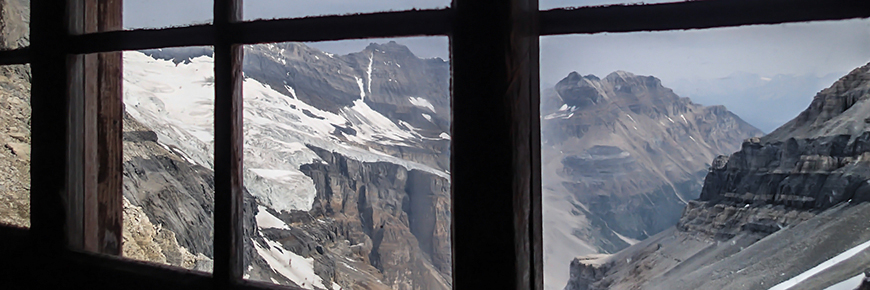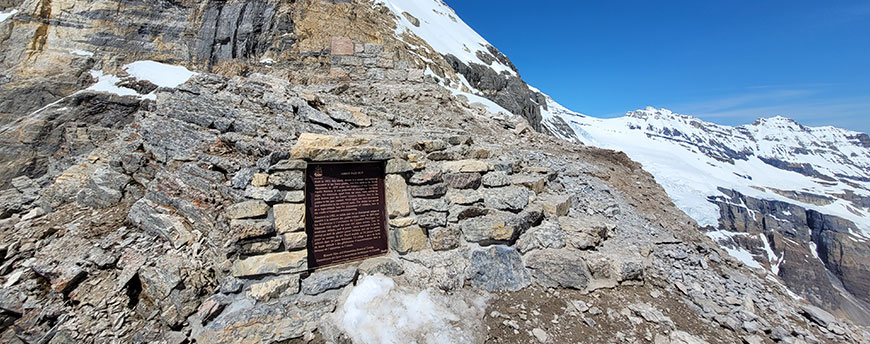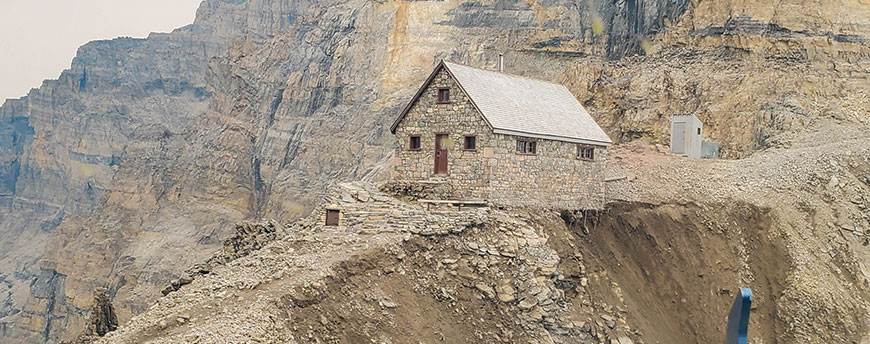
About
Abbot Pass Refuge Cabin National Historic Site
Abbot Hut was built by hand in 1922 by Swiss mountain guides using locally quarried, hand-cut stone and supplies ferried by boat, carried on horseback and on foot to the 2925 metre (9598 feet) col (or pass). The stone hut blends with the background and has withstood a century of snowstorms and gale force winds. The sturdy design and connection to the golden age of Canadian mountaineering made it a national historic site.
Updates on Abbot Pass Refuge Cabin National Historic Site
September 2023 Update: What We Heard
In 2023, Parks Canada asked Canadians how best to remember Abbot Pass Refuge Cabin National Historic Site. The results of public engagement are shared in a What We Heard Report about this nationally significant heritage place.
- What We Heard – Remembering Abbot Pass Hut National Historic Site (coming soon!)
The What We Heard Report shares the results of two phases of public engagement:
- Phase 1 – What should be remembered about this heritage place?
- Phase 2 – How should we remember this heritage place (i.e. actions)?
A working group, led by the Alpine Club of Canada, has expressed an intention to submit a development proposal for a structure to replace Abbot Pass Refuge Cabin. No formal application has been received at this time. Because it will be considered through a separate process, a replacement hut was not considered in public engagement.
April 2023 Update: Public Engagement Begins
As part of Parks Canada’s commitment to honouring the importance of the Abbot Pass Hut National Historic Site, we are connecting with Canadians on ways to commemorate this nationally significant heritage place.
The commemoration process begins with an online public survey to identify why Canadians believe the hut mattered and what was important to them. The survey can be completed between April 20 until May 22, 2023.
- LetsTalkMountainParks.ca – Tell us why Abbot Pass Hut National Historic Site matters to you. (Note: This survey has since been archived).
This information is being collected to help identify the “heritage values” of Abbot Pass Hut. Further phases of engagement will take place later this year to make specific recommendations on how to share these “heritage values” in future.
What are heritage values?
Heritage values are what make a heritage place significant to a community of people. They are comprised of the many meanings and values that people attach to a place. These values may change over time and Parks Canada would like to know how Canadians value Abbot Pass Hut today.
Heritage values can be both tangible and intangible. Tangible heritage values include things like architecture, archaeology, or natural landforms, whereas intangible heritage values include things like historic events, stories, memories, sense of place or traditional activities.
Taken together, they help provide the details about what make a heritage place special to Canadians.
What is a heritage place?
The significance of any place, including Abbot Pass Hut, cannot be separated from its environment or the activities that took place there. Public engagement asks participants to consider the whole experience of Abbot Pass Hut – the hut, the pass, the approaches to and from it, and the activities and stories that took place there. For the purposes of this survey, we will refer to these together as “Abbot Pass Heritage Place”.
Engagement scope:
The engagement process will help Parks Canada understand why the hut mattered to Canadians and guide the development commemorative activities and or installations to help express those values.
It will help answer questions like:
- Why did Abbot Hut matter and what were its heritage values?
- Has its significance changed over time?
- Who are we trying to reach with commemoration?
- Which heritage values or themes should be prioritised?
It may also help answer questions like:
- What forms could interpretation take?
- Where could interpretation take place?
- How could salvaged components of the hut be used in interpretation?
The engagement process will not consider:
- New habitable structures at Abbot Pass or elsewhere
- Management of visitor use at Abbot Pass (e.g. what activities are permitted)
- Permanent interpretive exhibits inside the Lake Louise Visitor Centre
- New place names in the Lake Louise area
Parks Canada is aware that a working group led by the Alpine Club of Canada plans to submit a development proposal for a new structure in place of Abbot Pass Hut. No formal application has been received at this time. Future proposals may be informed by public engagement but will not be considered as part of this engagement process.
Next steps:
The public survey will remain open until May 22, 2023.
In early summer 2023, Parks Canada will work with interested Indigenous communities and key stakeholders to recommend new and existing opportunities to share the heritage values of Abbot Pass Hut Heritage Place. Recommendations may involve collaboration with third parties.
Later in 2023, Parks Canada will create a commemoration plan for Abbot Pass Hut Heritage Place that describes how we will communicate its heritage values in future.
- LetsTalkMountainParks.ca – Tell us why Abbot Pass Hut National Historic Site matters to you. (Note: This survey has since been archived).
July 2022 Update: Hut Removal Work Completed
On June 30, 2022 Parks Canada and its contractors completed the substantial removal of the Abbot Pass Refuge Cabin (Abbot Hut).
Contractors carefully dismantled the hut using powered hand tools. The interior walls, wooden beams, roof, windows and other manufactured materials were dismantled and removed from the site by helicopter.
The stone walls were deconstructed by hand and the mortar used to hold the stones in place was separated from the stones. Both the stones themselves, which were quarried on-site from Abbot Pass, and the mortar and have been distributed around the pass.
A small ruin has been left standing, including a section of wall, the commemorative plaque and the adjacent stone steps.
In addition to the previously known impacts to the foundation and cracking in exterior walls, workers found extensive signs of cracking and failure. The entire structure had been compromised and it is clear that the only safe option for the hut was dismantlement.
Parks Canada and its contractors also documented the removal of the hut with photographs and oral history recordings while being mindful of safety at the site. Work was undertaken in consultation with archaeological and cultural heritage specialists, and notable artefacts from the hut, including the 1922 date stone, were removed for preservation.
Parks Canada will be working with the Alpine Club of Canada, Indigenous groups and other stakeholders to identify options for remembering the story of the hut and its heritage values including its contribution to rustic design architecture and its importance to mountaineering in Canada. Details of the process are being developed and will be released as soon as they are available.

The ruin that remains at Abbot Pass February 2022 Update: Parks Canada Announces Hut Removal

Like a number of historic places, the Abbot Pass Refuge Cabin Historic Site (Abbot Pass Hut) has been negatively impacted by the effects of climate change. Slope erosion and glacial recession have caused structural damage to the hut despite extensive stabilization efforts and interventions made to preserve the refuge in its location. As a result, Parks Canada has made the difficult decision to dismantle and substantially remove the Abbot Pass Hut in spring 2022. This action is necessary to mitigate a significant visitor safety risk posed by the current condition of the site.
Following reports of rockfall and erosion in fall 2016, Parks Canada conducted geotechnical assessments and monitored the slope beneath the hut for stability. Significant slope stabilization work was completed in 2018, including the installation of rock anchors to better support the hut. Geotechnical assessments conducted in 2021 found higher levels of slope erosion and new evidence, including cracks in the masonry, that reveal the entire hut has been impacted.
Visitor safety is a top priority for Parks Canada and an area closure remains in place for Abbot Pass and the Abbot Pass Hut. Based on expert assessments, additional slope stabilization work is unlikely to be successful in preventing further erosion. Parks Canada has explored a number of conservation options, but it has become clear that the Abbot Pass Hut cannot be conserved in its current location and cannot be effectively moved.
Parks Canada recognizes the importance of Abbot Hut to many Canadians, particularly those in the climbing and alpine communities. We offer special thanks to them and to Alpine Club of Canada for operating the hut from 1985 until its closure in 2016.
Consultations with Indigenous groups, stakeholders and the public are planned for 2022 to help identify options for continuing to commemorate the story of the Abbot Pass Hut and its importance to the history of architecture and mountaineering in Canada.
Climate change and other environmental forces are challenging the integrity of ecosystems and the condition of the natural and cultural resources administered by Parks Canada. Parks Canada is continuing work to understand the impacts of climate change and to explore adaptation and mitigation strategies.
Timeline summary
- 1922: Abbot Pass Refuge Cabin (Abbot Pass Hut) constructed
- 1968: Dominion Parks Branch (known today as Parks Canada) acquires the hut
- 1973: Abbot Pass Refuge Cabin is restored
- 1985: Alpine Club of Canada assumes operation of the hut
- 1992: Abbot Pass Refuge Cabin is designated as a national historic site
- 2012: Parks Canada completes roof and drainage upgrades
- 2014: Parks Canada completes stone masonry restoration
- 2016: Initial slope instability reported to Parks Canada.
- 2017: Slope stability geotechnical assessment begins.
- 2018: Hut closed and initial slope stability work conducted to install rock anchors below the hut
- 2019: Additional slope stability work not completed due to unfavourable weather conditions causing safety concerns at the site.
- 2020: COVID-19 health measures prevent additional slope stability work from being completed.
- 2021: Further slope erosion occurs, impacting the base of the hut
- Area closure expanded to include Abbot Pass and its two approach routes.
- Second geotechnical assessment conducted.
- Heritage recording completed.
- 2022: Abbot Pass Hut removed
- 2023: Parks Canada conducts public engagement on how best to share the heritage values of Abbot Pass Refuge Cabin in future
Frequently asked questions
What caused the deterioration of the slope?
Abbot Pass Hut is located at 2925 metres in elevation on a windswept mountain pass (a col) along the continental divide, meaning that the pass and the hut are subjected to extreme weather throughout the year. But since the hut was built in 1922, climate conditions have changed in this mountain range. In 2016, it was first noticed that the permanent snow and ice, which has covered the southeast slope below the hut since its construction, had receded. This exposed the underlying rock and soil to weather elements.
Mountains are often geologically active places. The steep, unconsolidated and frozen nature of the slope increased its susceptibility to thawing and surface water erosion which likely contributed to the erosion of a portion of the slope. It is believed that high temperatures experienced in summer 2021 contributed to further erosion of the slope below the hut itself, impacting an area that was previously rock and ice.
What work has Parks Canada been doing at Abbot Pass?
Following reports of rockfall and erosion in fall 2016, Parks Canada conducted geotechnical assessments and monitored the slope for stability.
In 2018, Parks Canada invested $600,000 on initial rock stabilization work, including the installation of rock anchors. In 2019, weather conditions at Abbot Pass did not allow for work to continue. In 2020 COVID-19 pandemic restrictions meant that work was not possible.
In 2021, additional geotechnical surveys were conducted to determine if further slope stabilization was possible. Based on the results of this survey, Parks Canada concluded that no option existed to conserve Abbot Pass Hut in its original state. Additional stabilization efforts may have delayed this outcome but could not have prevented it.
Parks Canada considered a range of options including attempting to deconstruct it in a way that would allow for the hut to be rebuilt – either at Abbot Pass, or another location. This option was not feasible for reasons associated with health and safety of Parks Canada staff and contractors, as well as the challenging technical aspects of conservation work involved in the removal and reconstruction.
In 2021, a thorough heritage recording took place. This record contributes to the existing knowledge of the site and documents its heritage value.
Abbot Pass Hut was substantially removed in June 2022. Parks Canada salvaged representative elements of the hut to help remember its legacy.
What were the findings of the 2018 geotechnical assessment?
The area on which the hut was built had three zones: soil and rock bound with ice; fractured bedrock and bedrock. The hut sat on an area of fractured bedrock and an area of soil and rock with ice, including surface ice. To ensure the area remained safe for use and to mitigate the effects of slope erosion which could impact the hut, the report recommended the installation of rock anchors and netting to help secure the underlying bedrock and slope. The initial installation of rock anchors was completed in 2018.
What were the results of the 2021 geotechnical assessment? Why were they different than the 2018 assessment?
The 2021 assessment found a higher than anticipated rate of permafrost thaw and as a result, higher levels of slope erosion than were predicted in 2018. The 2018 report also likely overestimated the amount of bedrock under the foundation of the hut.
The 2021 assessment also found new evidence, including cracks in the masonry, that revealed the entire hut had been impacted by slope erosion.
Based on the assessment’s findings it is highly unlikely that additional slope stabilization efforts would have been a permanent solution for preserving the hut in its original location. Therefore, Parks Canada planned for the hut’s substantial removal in Spring 2022.
What does “substantial removal” of the hut mean?
Substantial removal means that the majority of the hut was removed from the site. Once Parks Canada staff and geotechnical engineers were able to access and assess the site in 2022, they determined that it was safe and feasible to leave a portion of the hut in it’s constructed state for commemorative purposes.
Can the hut be reconstructed somewhere else?
When planning for the substantial removal of the hut, the Agency considered attempting to deconstruct it in a way that would allow for the hut to be rebuilt, either at Abbot Pass or at another location. This option was not feasible for two reasons:
- The unstable condition of the hut and the slopes at Abbot Pass meant that the delicate work required for this type of removal would pose too great a risk to the health and safety of Parks Canada staff and contractors.
- Based on consultations with experts in historical masonry, the type of material used to construct the hut (primarily limestone) was likely to fracture if moved and was not conducive to removal and reconstruction.
Plans were being made to salvage some material from the hut for use in future commemoration of the site. Parks Canada is working with interested parties to identify options for commemorating the enduring national significance of the site itself, the surrounding area, and to mountaineering in Canada.
How will Abbot Pass Hut be remembered?
In 2023, Parks Canada asked Canadians what should be remembered about this nationally significant heritage place and what activities would be most welcomed. The results of public engagement will be shared through a What We Heard Report expected in autumn 2023. This report will inform future efforts to conserve and share the heritage values of Abbot Pass Refuge Cabin.
Why is public engagement necessary?
Public engagement is a requirement of the Federal Heritage Buildings Review Office (FHBRO) whenever a FHBRO building is dismantled.
Abbot Pass Refuge Cabin was a FHBRO classified heritage building and a national historic site as designated by the Historic Sites and Monuments Board of Canada (HSMBC). Parks Canada is required to ask Canadians about the heritage values of this heritage place and make plans to communicate those values in the future.
Heritage values are what make a heritage place significant to a community of people. They are comprised of the many meanings and values that people attach to a place. These values may change over time and Parks Canada would like to know how Canadians value Abbot Pass Hut today.
- Date modified :